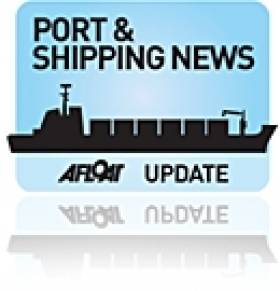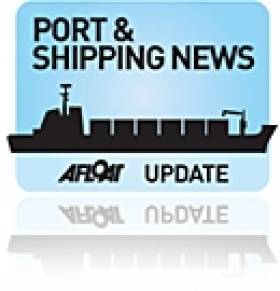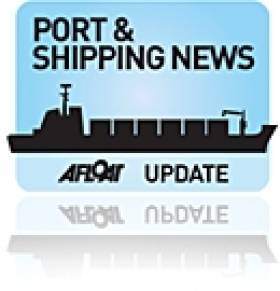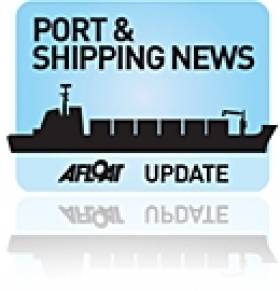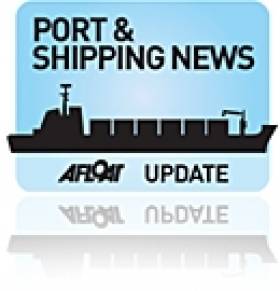Displaying items by tag: Shipping
Imminent Transfer of Genmar Oil Cargo
#GENMAR – After delays due to bad weather, the operation to remove 54,304 tonnes of Vacuum Gas Oil from the merchant vessel Genmar Companion is expected commence imminently (6th January).
Both ships are currently being manoeuvred together by tugs and are being held side- by-side 1.5miles out in Belfast Lough. The cargo is transferred from one to the other using specialist equipment.
The operation to berth, make lines secure and conduct final checks will take several hours before the actual transfer of the oil begins.
The operation to offload the cargo to the tanker BW Seine is expected to take between 24 and 36 hours. For the duration of the operation there will be a one- mile exclusion zone around the Genmar Companion and BW Seine to give the tugs a safe working area.
Ship-to-Ship Transfer of OIl Cargo Delayed Yet Again
#SHIPPING - The transfer of hazardous cargo from the stricken tanker at the entrance to Belfast Lough has been delayed yet again due to winds nearing hurricane strength.
The Belfast Telegraph reports that the Genmar Conpanion - which was redirected to Belfast after reporting a cracked hull en route from Rotterdam to New York - will remain sheltering off the Copeland Islands until the weather improves.
As previously reported on Afloat.ie, the ship-to-ship transfer of 54,000 tonnes of vacuum gas oil was originally scheduled to take place on 31 December last, but the task was pushed back as the receiving ship, BW Seine, was delayed by weather in the North Sea.
It had then been hoped to begin the transfer early yesterday with the receiving ship's arrival, but the strong storm-force winds that have increasingly battered Ireland in the last 36 hours put paid to those plans.
Ship-to-ship transfers can take place in wind speeds of up to 35 knots, but yesterday the wind speed in Belfast Lough was reported as more than double that.
Hugh Shaw, the NI Secretary of State's representative for maritime salvage and intervention, told the Belfast Telegraph: "As soon as we have a window to do the ship-to-ship transfer safely we will take it.
"Winds have been dropping a bit, but it looks unlikely the operation will take place on Wednesday."
Ship to Ship Transfer of Oil Cargo will Start Tomorrow
#SHIPPING – After delays due to bad weather, the operation to remove 54,304 tonnes of Vacuum Gas Oil from the merchant vessel Genmar Companion is now scheduled to commence later today (2nd January). The offload tanker BW Seine has now arrived on scene and is anchored close to the Genmar Companion in Belfast Lough.
The Genmar Companion has been sheltering off the Copeland Islands at the entrance to Belfast Lough since 16 December. It was 40 miles west of Tory Island, Co. Donegal, on its journey from Rotterdam to New York, when the Master reported a crack on its upper deck. This crack did not appear to extend to any of the oil cargo holding structures but, as a precautionary measure, the vessel's Master chose to seek both shelter and advice before continuing passage.
The Bermudan-flagged product tanker made its way to the Lough to enable surveyors to inspect the ship. The inspection, by the owners, a representative of the classification society (American Bureau of Shipping) and the MCA took place on 18 December.
Following this inspection all parties agreed that, as a precautionary measure, the cargo should be removed and the ship repaired. As there are no shore reception facilities at Belfast Harbour for a tanker of this size the only option is to transfer the cargo to another vessel (known as Ship To Ship Transfer).
Hugh Shaw, The Secretary of State's Representative for Maritime Salvage and Intervention said:
"The Ship to Ship transfer operation was originally scheduled to commence on the 31 December, but was delayed primarily due to poor weather conditions experienced by BW Seine en route from Sweden to Northern Ireland. It is also essential that the operation does not impact on the day to day operations of Belfast Harbour.
Subject to availability of tugs, and providing conditions are suitable, both vessels will be placed alongside each other later today and the actual oil transfer will commence shortly thereafter.
This ship to ship transfer will be carried out by Fendercare Marine and the process is expected to take approximately 24-36 hours.
On completion of the operation the Genmar Companion will enter Belfast Harbour for repairs."
Northern Ireland Environment Minister, Alex Attwood, said:
"I have been advised that the transfer operation will be started later today, weather permitting. Over the period of this incident, I have been actively seeking reassurances that there is no threat to our marine environment. It is good to see that the plan is now coming together, despite the weather over the last few days. I am continuing to keep a close eye on all the developments. My officials are working closely with the Maritime and Coastguard Agency and are keeping me fully briefed."
Transfer of Cargo from Stricken Tanker Delayed
#SHIPPING - The transfer of cargo from the damaged oil tanker sheltering at the entrance to Belfast Lough has been posponed for at least two more days.
As previously reported on Afloat.ie, the 228-metre Germar Companion - which is carrying 54,000 tonnes of vacuum gas oil - was redirected to Belfast after reporting a cracked hull en route from Rotterdam to New York.
The merchant vessel has been sheltering off the Copeland Islands since 16 December, where an official examination recommended removal of the cargo.
Today (31 December 2011) had been the scheduled start date for the move of the tanker's hazardous cargo by ship-to-ship tranfer. But the move has been delayed as the second ship, the BW Seine, is still en route to Belfast Lough.
"It is currently in the North Sea and could take another two days before it reaches the vessel and starts to transfer the cargo," a coastguard spokesperson told the Belfast Telegraph.
The transfer will be managed by specialist company Fendercare Marine in the lough, and could take between 24 and 36 hours. Once finished, the Germar Companion will sail into Belfast for repairs.
Cracks in Hull Force Tanker Re-Routing to Belfast
#SHIPPING - The Irish Times reports that a tanker carrying hazardous cargo has been allowed to berth at Belfast Port after it reported a cracked hull off the north-west coast.
The 228-metre Germar Companion, which is is carrying 54,000 tonnes of vacuum gas oil, was on route from Rotterdam to New York when its crew discovered cracking in its upper deck some 25 miles off Tory Island.
The Air Corps and Naval Service were stood down after the cargo ship was granted permission to berth at Belfast, where its hull will be inspected.
Public Needed to Help Record Whale and Dolphin Strandings in UK
#MARINE WILDLIFE - Some 46 reports of stranded whales and dolphins in Northern Ireland are among the thousands recorded across the UK over the last six years, according to BBC News.
A new study co-ordinated by the Zoological Socoety of London (ZSL) shows that some 3,500 cetaceans were stranded on the British coastline between 2005 and 2010.
Though year-on-year figures have fallen overall, is presumed that many more strandings have gone undetected.
Many were found to have died of disease or starvation – particular harbour dolphins.
But human activity such as fishing, shipping and chemical pollution also poses a significant threat to marine wildlife in the waters around the British Isles, said Rob Deaville of the ZSL.
The public is being encouraged to report stranded marine mammals to help create a more accurate picture.
BBC News has more on the story HERE.
Trade Freight Volumes Through Seaports Still Down 9% on 2007
#SHIPPING – The Irish Exporters Association launched its Trade and Transport Analysis 2011 today (13th Dec) in Cork and its findings confirmed that 2010 was a story of recovery after two straight years of decline in 2008 and 2009. Importantly, the recovery trend has not continued into 2011, and exporters fear that shipping lines may not be able to continue the service levels they need to meet new market requirements.
Speaking at the launch of the Trade and Transport Analysis 2011 at the Port of Cork, Mr John Whelan, Chief Executive at the Irish Exporters Association, said that the analysis shows;
• export volumes have now returned to the pre –recession levels
• but import volumes are still 12.9% below 2007 levels. The analysis further shows that airfreight imports are down by 36% indicating a dramatic loss in high value luxury imports, whereas sea-freight imports are down by over 9%, reflecting the depressed domestic economy.
Mr Brendan Keating, Chief Executive Officer at the Port of Cork, welcoming exporters to the launch event stated; ''A 9% increase in exports are expected through the Port of Cork during 2011, which is very positive for the region.''
He went on to say the Port of Cork is committed to supporting the growth of international trade and meeting the needs of exporters and importers of goods , particularly from the distant but rapidly growing Asian and South American markets . He also pointed to the Ports commitment by sponsoring the Deep Sea Shipping Award with the Irish Exporters Association. He concluded by saying; "The Port of Cork is happy to be associated with the Irish Exporters Association in producing the Trade and Transport Analysis 2011."
"The growth in exports volumes to pre –recession levels reflects the rapid' V ' shaped bounce back by the export sector which was achieved despite the depressed international economic environment," said Mr Whelan. However, he went on to say, the continued low volume of imports is inevitably putting huge strain on the shipping lines and airfreight lines servicing the country. "Exporters are concerned that the continued loss of volumes will lead to a deterioration of competitive services from shipping lines and haulage contractors, less revenue for ports and ultimately higher transport costs for our manufacturing export sector."
He further stated; "Major job losses in manufacturing industry will accelerate unless a new integrated transport strategy is put in place to enable Irish exporters to effectively transport key imports from the major Asian supply industries into Ireland and manufacture and distribute exports into Europe and America as well as back to Asia."
John Whelan then said; "In this context exporters find it befalling that in the recent Budget that added costs were put onto the transport sector without making allowances for the export sector . Once again we are asking the Minister for Transport Leo Varadkar T.D. to introduce a Special Diesel User Rebate to support transport and export industry to ensure we have a level playing field in Europe with competitors from other EU member states who enjoy this kind of support from their governments."
The publication launched today, sponsored by the Port of Cork, looks in detail at all of the various modes of transport that are currently used to export and to import. The publication also looks at the risk factors to Irish trade which need to be addressed as a matter of urgency. High up on that list is the lack of regular air freight routes into and out of Ireland which accounts for 37% by value of all exports or almost €33 billion were carried by air in 2010. However, this may not be the full picture because the CSO figures only indicate the mode of transport used to move the goods across the border of the Irish state and does not take into account which mode of transport is used after that point. It therefore seems likely that the figures for air freight quoted above may in fact not reflect the total potential airfreight value as it is likely that a proportion of air freight is leaving Ireland by other modes in order to be air freighted from hubs in the UK or continental Europe to their final destination.
Mr Whelan concluded by saying that Ireland must continue to reinforce its existing strengths as one of the most open and globalized economies in the world (currently ranked Number Two on the Ernst & Young Globalization Index). "We must build on our progress so far by effectively resolving our transport challenges in an imaginative way and with a strong sense of urgency and determination."
The Timber Traders and Days of Old Irish Sea Shipping Companies
#PORTS & SHIPPING- The general dry-cargo vessel, Red Duchess berthed at Ardrishaig on Scotland's west coast at Loch Fyne today, after completion of a voyage from Waterford, writes Jehan Ashmore.
The 1969-built coaster rounded the Hook Head Lighthouse yesterday around noon, having departed Belview on Waterford Estuary. She is engaged on the Irish Sea timber trade, which have been the mainstay of the cruiser stern-vessel's career (see PHOTO).This feature maybe commonplace among yachting craft, yet it is an increasing rare feature, to be found on commercial ships these days.
Her builders were Bodewes Hoogezand Scheepswerf, Bergum of The Netherlands, though the veteran vessel received a modernisation programme in 1995. In addition to the 1,285grt Red Duchess, her fleetmate Red Baroness (1979/964grt) is also actively employed on the same trade.
Each vessel has a single 80m box-hold which can also handle coal, fertiliser, salt and stone. The UK flagged vessels are owned and managed by Coast Lines Shipping based in Midleton, Co. Cork which was established in 1981. For photos of the fleet and technical details, click HERE.
The name of the Irish shipping company revives the similarly named Coast Lines which was synonymous with the British & Irish Steam Packet Co. Ltd otherwise known as B+I Line. By 1917 the Coast Lines group operated seven Irish shipping companies and held all the shares in B+I Line.
The group also had a half interest in David MacBrayne, which was together acquired in the same year by Lord Kylsant's Royal Mail Steam Packet. It was during the Kylsant period that one of their vessels, the 696 ton Lochfyne served David MacBrayne. The Kylsant shipping empire collapsed and Coast Lines regained independence in 1935.
It is apt to have these historical associations as successors to David MacBrayne, now Caledonian MacBrayne (CalMac) are Scotland's largest island ferry network which includes the Loch Fyne ferry (PHOTO) route of Portavadie-Tarbert with the remote location of Ardrishaig further up the Loch.
By 1965 Coast Lines sold their British & Irish (including the associated City of Cork Co.) to the Irish Government and the remaining part of the company was purchased by P&O in 1971. This marked an end of era, with the names of several Irish Sea freight and ferry operators slipping away.
As for Coast Lines Shipping, which was established in 1981, both Red Duchess and Red Baroness are on a time charter arrangement with JST Services. The Ayr-based company provide an integrated shipping, handling and road haulage timber business in addition to the carriage of other cargoes.
Asides serving Ardrishaig, the red-hulled vessels call to their adopted homeport of Ayr, Campbeltown and Sandbank. In addition they call to Troon, where both coasters are registered (see PHOTO). From these ports they sail to Irish ports, in particular Derry, Youghal and Passage West, a privately-owned wharf in the centre of Cork Harbour.
Timber products can include logs, which are loaded by a grabber as depicted in this PHOTO taken at Passage West. The facility also deals in scrap-metal cargo, where a mounting pile is clearly evident on the quayside, awaiting to be disposed for export.
- Shipping
- Irish ports
- irish sea
- Red Duchess
- Coast Lines
- Hook Head Lighthouse
- Caledonian MacBrayne
- B&I Line
- Ports & Shipping news
- timber
- British & Irish Steam Packet Co
- Coast Lines Group
- Coast Lines Shipping Ltd
- JST Services
- Belview Waterford
- Red Baroness
- Irish Sea shortsea coasters
- Irish Sea fshipping companies
- CalMac
- Royal Mail Steam Packet
- Irish Sea coasters
- Irish Sea short sea shipping
- Loch Fyne Scotland
- David MacBrayne
- Passage West Cork Harbour
- Cork Harbour
- PortavadieTarbert
- MV Isle of Cumbrae
Port of Cork Announce Agri-food Sector Investment
Arkady Feed Ltd is a leading player in the importation and trading of feedstuffs for the animal feed sector in Ireland. The animal feed sector is a vital link in Ireland's €8bn agri-food sector. The construction of this new store by Arkady Feed Ltd is a vote of confidence in the animal feed and agri-food sectors by the company. BAM contractors have been awarded the contract to build the facility on behalf of Arkady Feed Ltd.
Minister Simon Coveney today said: "I wish Arkady Feed Ltd every success for their new bulk feed store here in Ringaskiddy, Co. Cork. The dry bulks sector is up 9% for the first 9 months of 2011, according to figures recently published by the IMDO, which shows that this sector is likely to see further growth in the future."
Gary McGuigan, a Director of Arkady Feed Ltd said: "This very important strategic investment in our own storage facility in the Port of Cork, will allow us to grow our business here in Ireland and be a stronger partner with our customers as they too grow over the coming years. While our industry is facing a number of serious issues that will hamper growth in the short term we feel very strongly that our industry is well placed for growth in the medium to long term."
Brendan Keating, CEO of Port of Cork Company said: "The Port of Cork Company is delighted that Arkady Feed Ltd has chosen Ringaskiddy as the location for this significant investment. We are confident that with our unique deep-water port facilities in Ringaskiddy we can help and support Arkady as they expand their business. In offering our full support we commit to working with Arkady Feed Ltd in the achievement of growth."
Shipping Volumes Up in First Quarter
First quarterly figures for 2011 show that volumes of shipping and port traffic on the majority of principal sectors grew, according to the Irish Maritime Development Office (IMDO).
The figures below outline a moderate trade volume growth in four out of the five key freight segments: Lift-on/ lift-off (lo-lo), Roll-on/Roll-off (ro-ro),dry-bulk, break-bulk and the tanker/liquid market.
• Total lift-on/ lift-off (lo/lo) trades volumes grew by 3%.
• Roll-on/Roll-off export traffic was also up 2% per cent on an all island basis.
• Dry bulk volumes through ROI ports increased by 21%,
• Breakbulk volumes were also up 25%
• The tanker/liquid market was the only sector to record a decline, down by -12% compared to the same period last year.
For further information about the figures, charts and a summary released from the IMDO click here


























